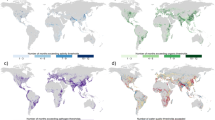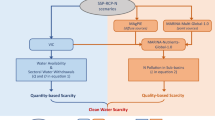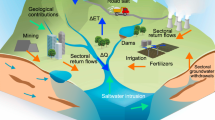Abstract
Human activities greatly impact surface water quality, while being reliant upon it for water supply. Surface water quality is expected to change in the future as a result of alterations to pollutant loadings, surface water withdrawals and hydrological regimes, driven by both climate change and socio-economic developments. Here we use a high-resolution global surface water quality model to project water temperature and indicators of salinity (total dissolved solids), organic (biological oxygen demand) and pathogen (fecal coliform) pollution until 2100. The results show that while surface water quality, as indicated by these pollutants, will improve in most advanced economies, the outlook for poorer nations is bleak. The proportion of the global population exposed to salinity, organic and pathogen pollution by the end of the century ranges from 17 to 27%, 20 to 37% and 22 to 44%, respectively, with poor surface water quality disproportionately affecting people living in developing countries. Exhibiting the largest increases in both the absolute and relative number of people exposed, irrespective of climate change and socio-economic development scenario, we conclude that Sub-Saharan Africa will become the new hotspot of surface water pollution globally.
This is a preview of subscription content, access via your institution
Access options
Subscribe to this journal
Receive 12 digital issues and online access to articles
$99.00 per year
only $8.25 per issue
Buy this article
- Purchase on Springer Link
- Instant access to full article PDF
Prices may be subject to local taxes which are calculated during checkout








Similar content being viewed by others
Data availability
Global hydrological and surface water quality output at 10 km resolution, per GCM and global change scenario (RCP–SSP), is available open-access at https://doi.org/10.5281/zenodo.7811612.
Code availability
The surface water quality model used in this study, DynQual, is available open-access through a GitHub repository (https://github.com/UU-Hydro/DYNQUAL).
References
Arnell, N. W. Climate change and global water resources. Global Environ. Change 9, S31–S49 (1999).
Haddeland, I. et al. Global water resources affected by human interventions and climate change. Proc. Natl Acad. Sci. USA 111, 3251–3256 (2014).
Konapala, G., Mishra, A. K., Wada, Y. & Mann, M. E. Climate change will affect global water availability through compounding changes in seasonal precipitation and evaporation. Nat. Commun. 11, 3044 (2020).
Kraaijenbrink, P. D. A., Stigter, E. E., Yao, T. & Immerzeel, W. W. Climate change decisive for Asia’s snow meltwater supply. Nat. Clim. Change 11, 591–597 (2021).
Trenberth, K. E. et al. Global warming and changes in drought. Nat. Clim. Change 4, 17–22 (2014).
Wada, Y. et al. Modeling global water use for the 21st century: the Water Futures and Solutions (WFaS) initiative and its approaches. Geosci. Model Dev. 9, 175–222 (2016).
Jones, E. R. et al. Current wastewater treatment targets are insufficient to protect surface water quality. Commun. Earth Environ. 3, 221 (2022).
van Vliet, M. T. H. et al. Global water scarcity including surface water quality and expansions of clean water technologies. Environ. Res. Lett. 16, 024020 (2021).
Jones, E. R. et al. DynQual v1.0: a high-resolution global surface water quality model. Geosci. Model Dev. Discuss. 2022, 1–24 (2022).
Jones, E. R., van Vliet, M. T. H., Qadir, M. & Bierkens, M. F. P. Country-level and gridded estimates of wastewater production, collection, treatment and reuse. Earth Syst. Sci. Data 13, 237–254 (2021).
Bosmans, J. et al. FutureStreams, a global dataset of future streamflow and water temperature. Sci. Data 9, 307 (2022).
Reder, K., Flörke, M. & Alcamo, J. Modeling historical fecal coliform loadings to large European rivers and resulting in-stream concentrations. Environ. Model. Softw. 63, 251–263 (2015).
Caretta, M. A. et al. in Climate Change 2022: Impacts, Adaptation, and Vulnerability. Contribution of Working Group II to the Sixth Assessment Report of the Intergovernmental Panel on Climate Change. (eds H.-O. Pörtner, D.C. Roberts, M. Tignor, E.S. Poloczanska, K. Mintenbeck, A. Alegría, M. Craig, S. Langsdorf, S. Löschke, V. Möller, A. Okem, B. Rama) pp. 551–712 (Cambridge Univ. Press, 2022).
Schewe, J. et al. Multimodel assessment of water scarcity under climate change. Proc. Natl Acad. Sci. USA 111, 3245–3250 (2014).
Riahi, K. et al. The Shared Socioeconomic Pathways and their energy, land use, and greenhouse gas emissions implications: an overview. Global Environ. Change 42, 153–168 (2017).
O’Neill, B. C. et al. The roads ahead: narratives for shared socioeconomic pathways describing world futures in the 21st century. Global Environ. Change 42, 169–180 (2017).
Wada, Y., Wisser, D. & Bierkens, M. F. P. Global modeling of withdrawal, allocation and consumptive use of surface water and groundwater resources. Earth Syst. Dynam. 5, 15–40 (2014).
Döll, P. et al. Risks for the global freshwater system at 1.5 °C and 2 °C global warming. Environ. Res. Lett. 13, 044038 (2018).
Hanasaki, N., Yoshikawa, S., Pokhrel, Y. & Kanae, S. A quantitative investigation of the thresholds for two conventional water scarcity indicators using a state-of-the-art global hydrological model with human activities. Water Resour. Res. 54, 8279–8294 (2018).
van Vliet, M. et al. Global river discharge and water temperature under climate change. Global Environ. Change 23, 450–464 (2013).
Sutanudjaja, E. et al. PCR-GLOBWB 2: a 5 arcmin global hydrological and water resources model. Geosci. Model Dev. 11, 2429–2453 (2018).
UNEP. A snapshot of the world’s water quality: towards a global assessment. United Nations Environment Programme, Nairobi, Kenya https://www.unep.org/resources/publication/snapshot-report-worlds-water-quality (2016).
Büchner, S. L. A. ISIMIP3b bias-adjusted atmospheric climate input data. ISIMIP https://doi.org/10.48364/ISIMIP.842396.1 (2021).
Hoch, J. M., Sutanudjaja, E. H., Wanders, N., van Beek, R. L. P. H. & Bierkens, M. F. P. Hyper-resolution PCR-GLOBWB: opportunities and challenges from refining model spatial resolution to 1 km over the European continent. Hydrol. Earth Syst. Sci. 27, 1383–1401 (2023).
Wanders, N., van Vliet, M. T. H., Wada, Y., Bierkens, M. F. P. & van Beek, L. P. H. High-resolution global water temperature modeling. Water Resour. Res. 55, 2760–2778 (2019).
Her, Y. et al. Uncertainty in hydrological analysis of climate change: multi-parameter vs. multi-GCM ensemble predictions. Sci. Rep. 9, 4974 (2019).
van der Wiel, K., Wanders, N., Selten, F. M. & Bierkens, M. F. P. Added value of large ensemble simulations for assessing extreme river discharge in a 2 °C warmer world. Geophys. Res. Lett. 46, 2093–2102 (2019).
Damania, R., Desbureaux, S., Rodella, A.-S., Russ, J. & Zaveri, E. Quality Unknown: the Invisible Water Crises (World Bank Group, 2019).
Barbarossa, V. et al. Threats of global warming to the world’s freshwater fishes. Nat. Commun. 12, 1701 (2021).
Wen, Y., Schoups, G. & van de Giesen, N. Organic pollution of rivers: combined threats of urbanization, livestock farming and global climate change. Sci. Rep. 7, 43289 (2017).
Desbureaux, S. et al. Mapping global hotspots and trends of water quality (1992–2010): a data driven approach. Environ. Res. Lett. 17, 114048 (2022).
GEMStat database of the Global Environment Monitoring System for Freshwater (GEMS/Water) Programme (UNEP, 2020); https://gemstat.org/data/data-portal/
Beusen, A. H. W. et al. Exploring river nitrogen and phosphorus loading and export to global coastal waters in the Shared Socio-economic pathways. Global Environ. Change 72, 102426 (2022).
Xie, H. & Ringler, C. Agricultural nutrient loadings to the freshwater environment: the role of climate change and socioeconomic change. Environ. Res. Lett. 12, 104008 (2017).
Morée, A. L., Beusen, A. H. W., Bouwman, A. F. & Willems, W. J. Exploring global nitrogen and phosphorus flows in urban wastes during the twentieth century. Global Biogeochem. Cycles 27, 836–846 (2013).
Van Drecht, G., Bouwman, A. F., Harrison, J. & Knoop, J. M. Global nitrogen and phosphate in urban wastewater for the period 1970 to 2050. Glob. Biogeochem. Cycles https://doi.org/10.1029/2009gb003458 (2009).
Jones, B. & O’Neill, B. C. Spatially explicit global population scenarios consistent with the Shared Socioeconomic Pathways. Environ. Res. Lett. 11, 084003 (2016).
Hurtt, G. C. et al. Harmonization of global land use change and management for the period 850–2100 (LUH2) for CMIP6. Geosci. Model Dev. 13, 5425–5464 (2020).
Gilbert, M. et al. Global distribution data for cattle, buffaloes, horses, sheep, goats, pigs, chickens and ducks in 2010. Sci. Data 5, 180227 (2018).
Graham, N. T. et al. Water sector assumptions for the Shared Socioeconomic Pathways in an integrated modeling framework. Water Resour. Res. 54, 6423–6440 (2018).
Lohrmann, A., Farfan, J., Caldera, U., Lohrmann, C. & Breyer, C. Global scenarios for significant water use reduction in thermal power plants based on cooling water demand estimation using satellite imagery. Nat. Energy 4, 1040–1048 (2019).
van Puijenbroek, P. J. T. M., Beusen, A. H. W. & Bouwman, A. F. Global nitrogen and phosphorus in urban waste water based on the Shared Socio-economic pathways. J. Environ. Manage. 231, 446–456 (2019).
Jones, E., Qadir, M., van Vliet, M. T. H., Smakhtin, V. & Kang, S.-M. The state of desalination and brine production: a global outlook. Sci. Total Environ. 657, 1343–1356 (2019).
Fick, S. E. & Hijmans, R. J. WorldClim 2: new 1-km spatial resolution climate surfaces for global land areas. Int. J. Climatol. 37, 4302–4315 (2017).
Fipps, G. Irrigation water quality standards and salinity management strategies. Texas FARMER Collection https://twon.tamu.edu/wp-content/uploads/sites/3/2021/06/irrigation-water-quality-standards-and-salinity-management-strategies-1.pdf (2003).
Zaman, M., Shahid, S. A. & Heng, L. in Guideline for Salinity Assessment, Mitigation and Adaptation Using Nuclear and Related Techniques 113–131 (Springer International Publishing, 2018).
Nahian, M. A. et al. Drinking water salinity associated health crisis in coastal Bangladesh. Elementa Sci Anthr. https://doi.org/10.1525/elementa.143 (2018).
Acknowledgements
M.T.H.v.V. was financially supported by the Netherlands Scientific Organisation (NWO) by a VIDI grant (VI.Vidi.193.019) and European Research Council under the European Union’s Horizon Europe research and innovation programme (grant agreement 101039426). We acknowledge and thank the Netherlands Organisation for Scientific Research (NWO) for the grant that enabled us to use the national supercomputer Snellius (project: EINF-3999).
Author information
Authors and Affiliations
Contributions
The research was designed by E.R.J., M.F.P.B. and M.T.H.v.V. The model runs, data analysis and paper writing were led by E.R.J., with feedback from M.F.P.B. and M.T.H.v.V. Data on wastewater scenarios and water use scenarios under the different SSPs were provided by P.J.T.M.v.P. and L.P.H.v.B., respectively. N.W. and E.H.S. aided in the development of the water quality model, and provided processed meteorological input data required for the model runs. All authors approved the paper.
Corresponding author
Ethics declarations
Competing interests
The authors declare no competing interests.
Peer review
Peer review information
Nature Water thanks Pinar Omur-Ozbek and the other, anonymous, reviewer(s) for their contribution to the peer review of this work.
Additional information
Publisher’s note Springer Nature remains neutral with regard to jurisdictional claims in published maps and institutional affiliations.
Supplementary information
Supplementary information
Supplementary Figs. 1–19.
Rights and permissions
Springer Nature or its licensor (e.g. a society or other partner) holds exclusive rights to this article under a publishing agreement with the author(s) or other rightsholder(s); author self-archiving of the accepted manuscript version of this article is solely governed by the terms of such publishing agreement and applicable law.
About this article
Cite this article
Jones, E.R., Bierkens, M.F.P., van Puijenbroek, P.J.T.M. et al. Sub-Saharan Africa will increasingly become the dominant hotspot of surface water pollution. Nat Water 1, 602–613 (2023). https://doi.org/10.1038/s44221-023-00105-5
Received:
Accepted:
Published:
Issue Date:
DOI: https://doi.org/10.1038/s44221-023-00105-5
This article is cited by
-
Global river water quality under climate change and hydroclimatic extremes
Nature Reviews Earth & Environment (2023)



